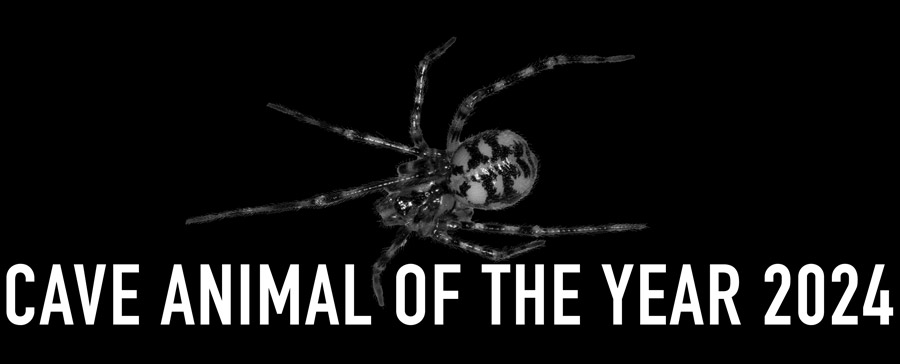
Comb-footed Cellar Spider - Cave Animal of the Year 2024

Introduction
The Comb-footed Cellar Spider (Nesticus cellulanus) was first described scientifically in 1757 by the Swedish entomologist Carl Alexander CLERCK. The species is very common in caves, cellars and mine tunnels. Outside caves it is found in screes, on walls and occasionally in forests. The Comb-footed Cellar Spider usually lives on the cave wall and ceiling, preferably in the transitional and deep regions. Here, it benefits from the generally high humidity. The spiders are found during the whole year in caves and other underground habitats.
The widespread distribution in our caves and the fact that the species is easily recognizable, even for the layman, led to the designation of the Comb-footed Cellar Spider as "Cave Animal of the Year 2024". The species is representative of a large number of animal species that depend on sheltered underground retreats.
At the same time, the Comb-footed Cellar Spider was also designated as the „European Spider of the Year 2024“. This illustrates the close cooperation between biospeleologists and the specialists for those species which live in caves. Arachnologists, as researchers of spiders are called, depend on the technical know-how and the knowledge of localities which cave researchers (speleologists) provide, to gain insights into the life of their species within their subterranean habitats.
Description
The front part (cephalothorax) of the Comb-footed Cellar Spider is yellowish in colour, with blackish markings. The underside of the cephalothorax is pale yellow with black spots, the legs are yellowish and ringed in black. The abdomen is greyish-yellowish with blackish spots. Males of this spider species grow up to 3.7 to 4.5 mm, females reach a size of 4 to 5.5 mm (without legs). The spider usually builds a wide-meshed carpet web in cavities in the cave walls, from which threads hang downwards. The lower part of each thread is covered with a very regularly arranged row of adhesive droplets. As soon as a prey animal becomes caught on the adhesive droplets, the spider throws more threads at it, then kills it with several bites of its poison fangs and pulls it up to the web carpet. The spherical egg cocoon, into which the female lays the eggs, is carried by the spider on its spinnerets until the young spiders hatch.
The Comb-footed Cellar Spider may be confused with the Pale Comb-footed Cellar Spider (Kryptonesticus eremita), which is much rarer in our country and also slightly lighter in colour. The dark central stripe on the cephalothorax retains the same width from front to back in the Comb-footed Cellar Spider and becomes narrow or non-existent from the middle onwards in the Pale Comb-footed Cellar Spider. A reliable identification is only possible by DNA barcoding or examination of the genitalia.
Distribution
The Comb-footed Cellar Spider is widespread and common throughout the whole of Europe as far as Turkey. It has been introduced into North America. Within Germany, the species is known from all cave areas.
In Europe, including Turkey and the Caucasus, a total of 58 species of the family Nesticidae (cave spiders) are known. The highest diversity is found in the Southern Carpathians (Romania) with 23 different species. Two other species of the family occur in Germany, Switzerland and Austria: Howaia mogera, an East Asian species occasionally found in greenhouses in Europe and widely dispersed, and Typhlonesticus idriacus, an endemic of the south-eastern Limestone Alps, which occurs in caves and alpine crevices in Austria, Italy and Slovenia.




